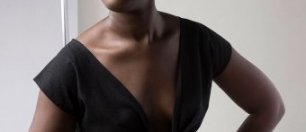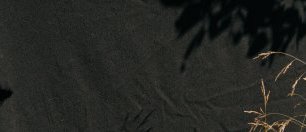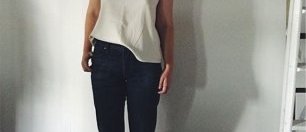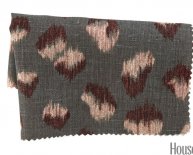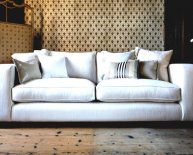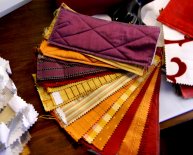
Silk broadcloth
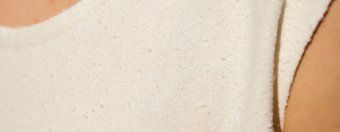 Fiber Content: 100% Silk
Fiber Content: 100% Silk
Weave: Broadcloth
Weight: 5.5oz/yd
How long it takes to biodegrade: 1-3 Years
Its natural properties: Silk has some pretty magical qualities. It has extremely high tensile strength - higher than any other fiber. A strand of silk is stronger than a wire of iron in the same diameter. It's naturally hypoallergenic (the most hypoallergenic of all fabrics), and is completely non-toxic. This means that neither the production of silk nor the breakdown of the fiber release toxins into the environment, and the fiber contains no toxins in it's makeup making it totally safe to wear. It biodegrades quickly and cleanly (synthetics take between 300-600 years to breakdown, and release chemicals into the soil as they do so). Silk retains moisture without feeling damp, so it's able to efficiently cool skin in the summer. It's also thermally stable, meaning it provides insulation in the winter. It has a natural elasticity, allowing it to stretch without breaking. The fact that it's a protein fiber gives it many of these qualities - it behaves like a part of you.
Where it’s made: China
How it’s made: Silk fabric is made from silk fibers, a product of the silk-worm. The fiber is used by the silk-worm to spin a cocoon, inside of which it transforms into a moth. What we think about the morality of using silk: Silkworms raised for their fiber are killed before emerging from their cocoons. There has been debate over the ethics of using silkworms for the production of silk, and some researchers are working to develop a way to effectively harvest silk from the cocoon without killing the worm. However, silkworms have been bred for silk production for over 4, 700 years and, in that time-span, both the worm and resulting moth have become dependent on human care. Silkworms no longer exist in the wild and cannot survive on their own. The worms must be human-fed, and they exclusively eat mulberry leaves. When the moth (bombyx mori) is permitted to emerge from its cocoon, it cannot see, fly, or eat. Therefore, even silk production that allows the moth to safely emerge from its cocoon will result in its death. Silk farming is not perfect, and I wish there were a way to produce a fiber of the same quality without causing any harm. This is a complicated issue, and one that we are happy to continue discussing, but because there is not a suitable alternative to traditional silk production that allows the worm or moth to live an improved life, we believe the benefits and highly useful natural properties of silk greatly outweigh the drawbacks. Synthetic alternatives to silk are made using petroleum products and toxic chemicals, are highly polluting, do not have the same beneficial properties as natural silk, take hundreds of years to biodegrade (during which they release toxins into the soil and air), and - by way of their low cost - lend themselves to creating excess waste. The cocoons are softened in soapy water to remove some of the gummy residue (called sericin), and the silk filament is unwound. It is reeled, by hand or machine, onto a wheel, and the end of each filament from one cocoon is twisted onto another, forming one long contiunous fiber. The reeled raw silk filament is packaged into skeins of 5-10 pounds each, and sent to be turned into yarn. The raw silk filament is sorted and categorized with similar skeins of weight and color. It is washed again to remove more of the sericin gum, and then several strands of filament are twisted together to create yarn. The tightness of the twist and the number of filaments twisted together determine the final texture of the finished fabric. Silk noil, or raw silk, as this particular finished fabric called, is made of shorter, coarser strands of filament that are twisted together. This gives it it's nubby, textured finish as multiple pieces of filament are joined together to create a single strand of yarn than in other types of silk.
When the moth (bombyx mori) is permitted to emerge from its cocoon, it cannot see, fly, or eat. Therefore, even silk production that allows the moth to safely emerge from its cocoon will result in its death. Silk farming is not perfect, and I wish there were a way to produce a fiber of the same quality without causing any harm. This is a complicated issue, and one that we are happy to continue discussing, but because there is not a suitable alternative to traditional silk production that allows the worm or moth to live an improved life, we believe the benefits and highly useful natural properties of silk greatly outweigh the drawbacks. Synthetic alternatives to silk are made using petroleum products and toxic chemicals, are highly polluting, do not have the same beneficial properties as natural silk, take hundreds of years to biodegrade (during which they release toxins into the soil and air), and - by way of their low cost - lend themselves to creating excess waste. The cocoons are softened in soapy water to remove some of the gummy residue (called sericin), and the silk filament is unwound. It is reeled, by hand or machine, onto a wheel, and the end of each filament from one cocoon is twisted onto another, forming one long contiunous fiber. The reeled raw silk filament is packaged into skeins of 5-10 pounds each, and sent to be turned into yarn. The raw silk filament is sorted and categorized with similar skeins of weight and color. It is washed again to remove more of the sericin gum, and then several strands of filament are twisted together to create yarn. The tightness of the twist and the number of filaments twisted together determine the final texture of the finished fabric. Silk noil, or raw silk, as this particular finished fabric called, is made of shorter, coarser strands of filament that are twisted together. This gives it it's nubby, textured finish as multiple pieces of filament are joined together to create a single strand of yarn than in other types of silk.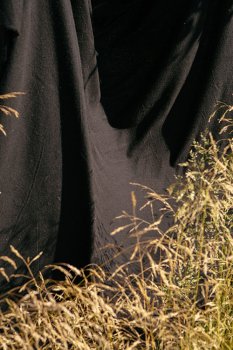 The twisted yarn is run through rollers to even out the thickness, it's inspected, packaged and sent for weaving. The finished yarn is degummed a final time to remove any remaining sericin, the yarn is dyed, and woven on a machine loom into final fabric.
The twisted yarn is run through rollers to even out the thickness, it's inspected, packaged and sent for weaving. The finished yarn is degummed a final time to remove any remaining sericin, the yarn is dyed, and woven on a machine loom into final fabric.
What it is: Ultra soft and forgiving, wearable matte silk. Raw silk is nubby and textured, and feels a lot like cotton but softer and with more drape. Lighter-weight than our linen, but a bit more durable than our silk crepe. We think silk is one of the best natural fabrics available. Nature has already given the fiber so many of the properties humans need in clothing, without having to add synthetics or chemicals or alter it's structure. It's highly functional, and at the same time indescribably beautiful. The drape and movement of silk on the body feels just as good as it looks.
How to wear it: This fabric is one of our favorites because it's suitable for year-round wear. Silk has excellent thermal stability, meaning it can be both insulating and breathable at the same time, feeling either cool or warm depending on the climate. In the winter, it will behave as a an insulating layer without adding bulk. In the summer, when skin is damp, it will cool the body by absorbing and evaporating without feeling moist. Wear your silk on it's own in the peak of summer, and layer it under wool and cotton in the fall and winter.
Care Instructions: Hand or machine wash cold, tumble dry warm. Use a mild detergent and the delicate setting on your machine. Yes, silk is machine washable! The only reason silk should change texture or shrink in the wash is if it hasn't been washed before you receive it. All of our garments - including the silk ones - are pre-laundered here before we ship them out. We test and account for shrinkage in the pattern itself, so after washing the garment shrinks to its correct size. Once you receive it, washing is totally safe! This is a natural fiber, so wash and wear will likely cause slight changes like subtle fading and softening over time, but this only makes the garments better in our eyes. Washing in cold water and washing only when necessary will minimize this. Hems, necklines, and sleeves will wrinkle - press with steam to shape and they'll return to pristine, crisp edges. Or, wear wrinkled, we love the look of this fabric rumpled and soft. Despite it's strength, silk is not particularly resistant to abrasion, so be mindful of high friction areas, and sunlight will weaken the protein-based fiber, so if you prefer to air-dry your clothing do so out of direct sunlight.
